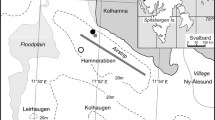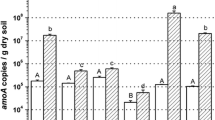Abstract
Autotrophic ammonia-oxidizing communities, which are responsible for the rate-limiting step of nitrification in most soils, have not been studied extensively in semiarid ecosystems. Abundances of soil archaeal and bacterial amoA were measured with real-time polymerase chain reaction along an elevation gradient in northern Arizona. Archaeal amoA was the predominant form of amoA at all sites; however, ratios of archaeal to bacterial amoA ranged from 17 to more than 1,600. Although size of ammonia-oxidizing bacteria populations was correlated with precipitation, temperature, percent sand, and soil C/N, there were no significant relationships between ammonia-oxidizing archaea populations and any of the environmental parameters evaluated in this study. Our results suggest that in these soils, archaea may be the primary ammonia oxidizers, and that ammonia-oxidizing archaea and ammonia-oxidizing bacteria occupy different niches.



Similar content being viewed by others
References
Austin AT, Yahdjian L, Stark JM, Belnap J, Porporato A, Norton U, Ravetta DA, Schaeffer SM (2004) Water pulses and biogeochemical cycles in arid and semiarid ecosystems. Oecologia 141:221–235
Avrahami S, Liesack W, Conrad R (2003) Effects of temperature and fertilizer on activity and community structure of soil ammonia oxidizers. Environ Microbiol 5:691–705
Belser LW (1979) Population ecology of nitrifying bacteria. Annu Rev Microbiol 33:309–333
Fierer N, Schimel JP, Holden PA (2003) Influence of drying-rewetting frequency on soil bacterial community structure. Microb Ecol 45:63–71
Francis CA, Roberts KJ, Beman JM, Santoro AE, Oakley BB (2005) Ubiquity and diversity of ammonia-oxidizing archaea in water columns and sediments of the ocean. P Natl Acad Sci U S A 102:14683–14688
Hastings RC, Butler C, Singleton I, Saunders JR, McCarthy AJ (2000) Analysis of ammonia-oxidizing bacteria populations in acid forest soil during conditions of moisture limitation. Lett Appl Microbiol 30:14–18
Hendershot WH, Lalande H, Duquette M (1993) Soil reaction and exchangeable acidity. In: Carter MR (ed) Soil sampling and methods of analysis. Lewis, Boca Raton, pp 141–145
Horz H-P, Barbrook A, Field CB, Bohannan BJM (2004) Ammonia-oxidizing bacteria respond to multifactorial climate change. P Natl Acad Sci U S A 101:15136–15141
Könneke M, Bernhard AE, de la Torre JR, Walker CB, Waterbury JB, Stahl DA (2005) Isolation of an autotrophic ammonia-oxidizing marine archaeon. Nature 437:543–546
Kowalchuk GA, Stephen JR (2001) Ammonia-oxidizing bacteria: A model for molecular microbial ecology. Annu Rev Microbiol 55:485–529
Leininger S, Urich T, Schloter M, Schwark L, Qi J, Nicol GW, Prosser JI, Schuster SC, Schleper C (2006) Archaea predominate among ammonia-oxidizing prokaryotes in soils. Nature 442:806–809
Mendum TA, Sockett RE, Hirsch PR (1999) Use of molecular and isotopic techniques to monitor the response of autotrophic ammonia-oxidizing populations of the β subdivision of the class Proteobacteria in arable soils to nitrogen fertilizer. Appl Environ Microbiol 65:4155–4162
Nicol GW, Schleper C (2006) Ammonia-oxidising Crenarchaeota: important players in the nitrogen cycle? Trends Microbiol 14:207–212
Norton JM, Alzerreca JJ, Suwa Y, Klotz MG (2002) Diversity of ammonia monooxygenase operon in autotrophic ammonia-oxidizing bacteria. Arch Microbiol 177:139–149
Okano Y, Hristova KR, Leutenegger CM, Jackson LE, Denison RF, Gebreyesus B, Lebauer D, Scow KM (2004) Application of real-time PCR to study effects of ammonium on population size of ammonia-oxidizing bacteria in soil. Appl Environ Microbiol 70:1008–1016
Rotthauwe J-H, Witzel K-P, Liesack W (1997) The ammonia monooxygenase structural gene amoA as a functional marker: molecular fine-scale analysis of natural ammonia-oxidizing populations. Appl Environ Microbiol 63:4704–4712
Schleper C, Jurgens G, Jonuscheit M (2005) Genomic studies of uncultivated archaea. Nat Rev Microbiol 3:479–488
Venter JC, Remington K, Heidelberg JF, Halpern AL, Rusch D, Eisen JA, Dongying W, Paulsen I, Nelson KE, Nelson W, Fouts DE, Levy S, Knap AH, Lomas MW, Nealson K, White O, Peterson J, Hoffman J, Parson R, Baden-Tillson H, Pfannkoch C, Rogers Y-H, Smith HO (2004) Environmental genome shotgun sequencing of the Sargasso Sea. Science 304:66–74
Wuchter C, Abbas B, Coolen MJL, Herfort L, van Bleijswijk J, Timmers P, Strous M, Teira E, Herndl GJ, Middelburg JJ, Schouten S, Damsté JSS (2006) Archaeal nitrification in the ocean. P Natl Acad Sci U S A 103:12317–12322
Zhou J, Bruns MA, Tiedje JM (1996) DNA recovery from soils of diverse composition. Appl Environ Microbiol 62:316–322
Acknowledgments
We would acknowledge the following funding sources: Office of Science (BER), U.S. Department of Energy, Grant no. DE-FG02–04ER63883, the National Science Foundation, Grant No. DEB-0416223. K.A. was supported by an NSF IGERT fellowship (grant no. DGE-0549505). We would like to thank Paul Dijkstra, Joey Blankinship, and Ben Moan for their assistance with field work and site data.
Author information
Authors and Affiliations
Corresponding author
Rights and permissions
About this article
Cite this article
Adair, K.L., Schwartz, E. Evidence that Ammonia-Oxidizing Archaea are More Abundant than Ammonia-Oxidizing Bacteria in Semiarid Soils of Northern Arizona, USA. Microb Ecol 56, 420–426 (2008). https://doi.org/10.1007/s00248-007-9360-9
Received:
Revised:
Accepted:
Published:
Issue Date:
DOI: https://doi.org/10.1007/s00248-007-9360-9




